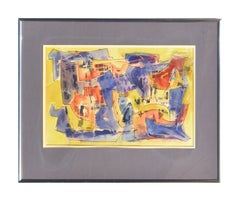Carl E Schwartz
Purple & Yellow Modern Urban Abstract
By Carl E. Schwartz
Located in Soquel, CA
Modern and bright urban abstract in yellow & purple by Carl E. Schwartz (American, 1935-2014), c
Category
1970s Abstract Expressionist Abstract Drawings and Watercolors
Materials
Paper, Ink, Watercolor
People Also Browsed
Mid Century Abstract Vertical Sunset
By Irene Pattinson
Located in Soquel, CA
Abstract watercolor fragment of a sunset over a field by Irene Pattinson (American, 20th Century). Tag on verso reads "Miller Fine Art / The Estate of Irene Pattinson". Unsigned. Acq...
Category
1960s Abstract Expressionist Abstract Drawings and Watercolors
Materials
Watercolor, Tissue Paper
Abstract Cityscape Watercolor
By Les Anderson
Located in Soquel, CA
Abstract cityscape watercolor with loosely defined landscape elements and geometric shapes by Les (Leslie Luverne) Anderson (American, 1928-2009). From the estate of Les Anderson in ...
Category
1980s Abstract Expressionist Abstract Drawings and Watercolors
Materials
Paper, Watercolor
"Sierra Country", Abstracted Landscape Watercolor
By Erle Loran
Located in Soquel, CA
Vibrant abstract landscape watercolor titled "Sierra Country" by Erle Loran (American, 1905-1999), 1984. Titled, signed, and dated on verso. Presented in a painted metal frame, witho...
Category
1980s Abstract Expressionist Abstract Drawings and Watercolors
Materials
Watercolor, Archival Paper
$2,080 Sale Price
20% Off
H 30 in W 37 in D 1 in
Project for Sculpture in Chalon-sur-Saône (unique sculptural drawing for France)
By Mark di Suvero
Located in New York, NY
Mark di Suvero
Project for Sculpture in Chalon-sur-Saône, 1992
Marker, Watercolor and Ink Wash on Paper.
Hand signed and dated by artist on lower right front
Frame included
The rare ...
Category
1990s Abstract Expressionist Abstract Drawings and Watercolors
Materials
Ink, Watercolor, Permanent Marker
Mark di SuveroProject for Sculpture in Chalon-sur-Saône (unique sculptural drawing for France), 1992
$15,000
H 24 in W 30 in D 0.5 in
Connecticut Hills
By Lyonel Feininger
Located in Miami, FL
This later work by Lyonel Feininger approaches almost full abstraction. It was executed in 1950 at a crucial moment in American art history. Abstract Expressionism and non-represe...
Category
1990s Abstract Expressionist Abstract Drawings and Watercolors
Materials
India Ink, Watercolor
Get Updated with New Arrivals
Save "Carl E Schwartz", and we’ll notify you when there are new listings in this category.
